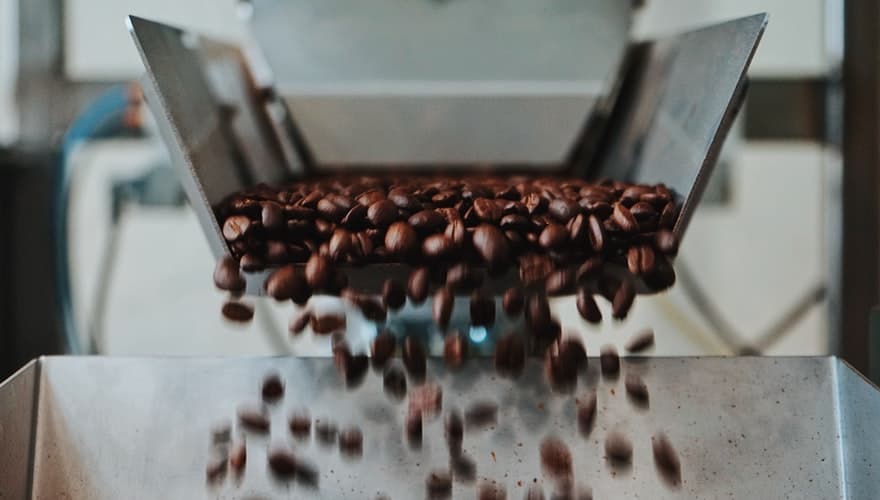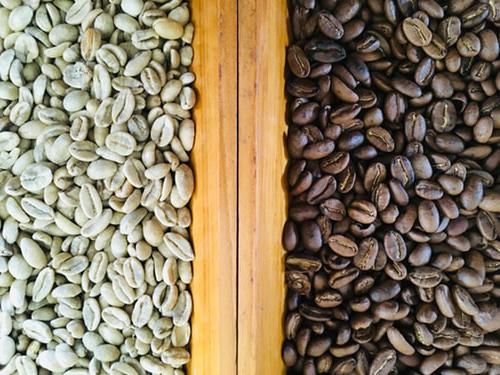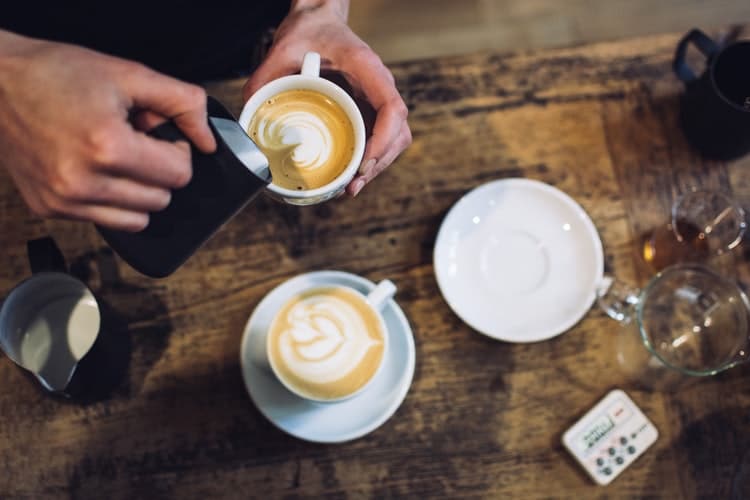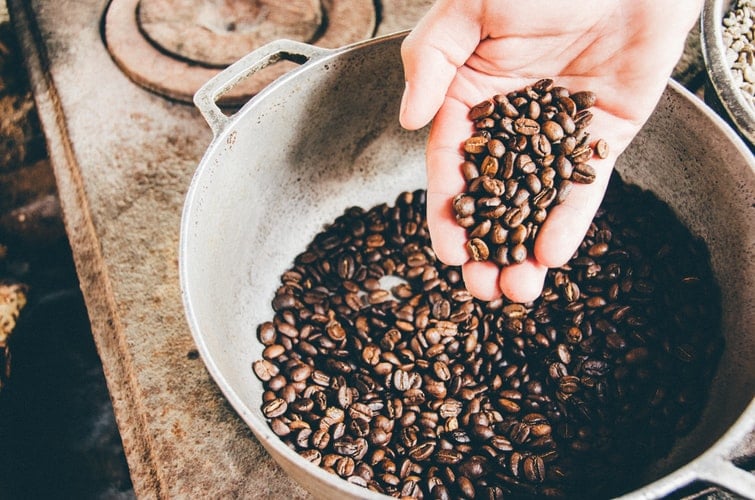Today, in the shops and supermarkets in our country, the number of coffee varieties is so great that you can easily get lost in their abundance. To avoid wasting time and money determining the most suitable brand for yourself, you need to know the features of different varieties and types of coffee beans.
Four Types of Coffee Beans

Arabica
The official name of the culture is the Arabian Coffee Tree (Coffea arabica). Arabica coffee – the most important type of coffee in the world – has a complex aroma. The culture is very whimsical. The optimal conditions for the existence of Arabica are mountain tropics at an altitude of 900 to 2100 m above sea level. The beans thrive in the humidity and the regular heavy rains. The average temperature at the place of growth is 15-24 °C. The most fertile condition is the complete absence of frost.
The number of varieties of Arabian Arabica trees that are used today in the coffee industry is 45-50. The period from the moment of flowering to the time of fruit ripening is 6-7 months. The number of crops per year is 1-2. The main criterion for the number of crops is the alternation of the drought and rainy seasons. Crops are usually propagated by viable seeds.
Robusta
The official name for this culture is Coffea Canephora Coffee Tree. It was discovered in the Congo Basin, Congo, Africa. Robusta – the second most popular type of coffee in the world – is characterized by a high caffeine content in beans. Robusta is used in coffee blends to give drink strength.
Robusta is unpretentious and tolerates heat and humidity well. The optimal conditions for the existence of culture are low-lying tropics at an altitude of up to 900 m. Robusta beans also enjoy humidity with regular heavy rains. The average temperature at the place of growth is 22-27 ° C. Growing soil characteristics are moist soil and high temperature.
Robusta is insensitive to diseases and harmful insects. The period from the moment of flowering to the time of fruit ripening is 5-6 weeks. The number of crops per year is 12-15. The main criterion for the number of crops is strict adherence to the care technique. Reproduction is catalyzed through cuttings.
Liberica
Liberian coffee is native to West Africa. Currently, this species is grown in almost all countries of the African continent, as well as Sri Lanka, Indonesia, the Philippines, and others. Farmers harvest Liberica coffee from the fruits of coffee trees 6-10 meters high with very large leaves. The length of the coffee fruit is 30-35 mm, the width is 10-15 mm.
The quality of Liberian fruits is not the highest, so this kind of coffee is rarely used. Mostly Liberica is used to create various coffee blends. No one has ever consumed coffee made entirely from Liberian beans. This seems to be impossible.
Excelsina
This is another type of coffee. Excelsia coffee – or High Coffee – is even less known than Liberica. Trees of this species reach a height of 20 m. This type of coffee has no economic value.
Main Types of Roasting Coffee Beans

It is impossible to create a single scale for the degree of roasting of coffee beans. Different beans have different tastes and the same bean, roasted in different ways, has its differences in taste. Also, we are all different and our tastes are subjective. “Strong” to some could be “weak” to others. The classification of types of the best coffee beans by roast level is accepted that dark shiny beans are French, Italian, Cuban and Spanish roast, and matte brown, amber or chocolate shades of beans are a weak and medium roast.
The degree of coffee roasting affects the taste, aroma, and strength of the resulting beverage, so it is important to be able to choose the option that you like best for this parameter.
Lightly roasted coffee
Lightly roasted – features obvious sourness and goes well with milk. The option for coffee roasting is suitable for softer beans and allows you to fully display a delicate aroma and multifaceted taste.
Examples of light roast coffee are cinnamon (Scandinavian), New English, American and City roast.
Scandinavian or cinnamon roasting (I degree)
The finished cinnamon roasted coffee has a delicate aroma and an incomplete body of taste. It is not strong, but pale brown. This method of roasting coffee beans is suitable for varieties of alpine Arabica from Jamaica and Kenya and Nicaragua. When roasting, the beans begin to exude a sour yeasty smell, which resembles the aroma of freshly baked bread.
New England roast (II degree)
The coffee bean begins to secrete more aromatic oils. Due to the release of saccharides and starch, the beans darken. New England roast bean espresso has a brighter aroma and taste, but still without enough expressiveness. The color of the finished coffee is light brown.
American Roast (III Degree)
American roasted coffee beans have a motley red color due to cracks. A coffee drink with a tangible sourness and a bright sweetish aroma. Typically, inexpensive coffee beans are roasted in this way. American roasting is suitable for coffee made in a French press or Turk.
City roast (IV degree)
When roasting City Roast, the beans acquire a nutty touch, which lets off the familiar “aroma of coffee.” Drops of essential oil appear on the beans and sugar is released. In appearance, the coffee becomes glossy, the color is brown. The taste of the drink becomes sweet, with a bright caramel aroma. In addition to Turks and a French press, City roasted beans are also suitable for a coffee machine.
Medium Roasted Coffee
Medium-roasted coffee is a traditional way of roasting to produce dark-colored beans with a dry oily surface. The drink is obtained with a bright sweet and sour aroma, more saturated than with weak roasting. Medium roast includes Full City Roast and Vienna.
Full City (V degree)
Beans acquire a dark color and light haze due to the burning of essential oils. Full City brewed roast coffee acquires a light bitterness along with sour and chocolate notes.
Most often used for coffee machines.
Vienna roast (VI degree)
During Viennese roasting, the bean acquires a dark brown color, the surface is oily and glossy. The taste of espresso is filled with characteristic coffee bitterness, it is rich and strong. Sourness disappears and a sweet caramel taste is noticeable.
Highly roasted coffee
Highly roasted coffee produces dark brown beans with weak traces of oiliness. The taste is less acidic than the previous options. With this method, essential oils are actively secreted, which contributes to the appearance of a brighter and more saturated aroma, which is revealed most fully. The brewed beverage turns dark. According to the European classification, the French roast is called a strong roast.
French roast (VII degree)
French roasting is one of the most popular for making espresso. Coffee beans become even darker brown with cracks on the surface. Coffee is dense and strong. You can taste the burnt caramel notes in the taste and the aroma is strong.
Dark Roast
The highest degree of roasting is characteristic of many European coffee-making styles. The beans are dark brown, almost black, and oily. The taste with a clear bitterness and a pleasant “scented” flavor, goes well with cream, but is popular in its pure form, like black afternoon coffee. Dark roast coffees are Spanish or Dark French roast.
Spanish or Dark French roast (VIII degree)
The appearance of the coffee bean is a greasy glossy surface, almost black. It becomes very brittle. Espresso made from Spanish roasted beans is thick and strong.
This is one of the most difficult degrees of roasting, which is not suitable for all types of coffee because some simply burn to ash. Due to the specific taste, Spanish roasted beans are rarely sold in pure form, more often they are used to create blends.
This is not to say which way of roasting coffee is better. This is determined only by the individual preferences of each person.
Country of Origin

How does the taste of the drink depend on the country of origin and the variety of coffee?
Coffee, like the grapes from which wine is made, reacts with its taste to soil composition, climatic conditions, and altitude. It changes its organoleptic characteristics by growing conditions.
It is important to know this when choosing a country of origin because the same type of coffee can significantly change its taste characteristics depending on the amount of precipitation, sunny days, and composition of the soil.
Also, today it is very common to create coffee blends, the taste of which can be adjusted to achieve the desired “sound” of the drink.
What kind of coffee do gourmets prefer?
Colombia
This country, being a giant in the coffee business and supplying 15% of the global coffee volume, produces high-quality Arabica, recognized as the best in the world. The main exported Kolambia coffee echoes the name of the country.
In Colombia, coffee of various qualities is produced: supremo, extra and excel.
Supremo. The best coffee variety using the latest processing technology to produce large and flat beans. It has a fairly rich taste and velvety aroma. For sale, unfortunately, it is very difficult to find.
Extra is slightly inferior in terms of quality, but, nevertheless, also high class. The size of the coffee beans is slightly smaller than that of supremo, and this indicator is one of the decisive factors when sorting coffee beans. The taste of coffee is very strong and full.
Exelso – a mixture of supremo and extra, which gives the coffee of this class a fairly strong acidity and a winy aftertaste.
The Pico variety produced in Colombia is distinguished by coniferous notes.
Guatemala
This country also boasts the production of high-quality coffee, recognized as one of the best in the world because it grows in mountainous regions, where, compared to the lowlands, coffee is produced with a more intense, tart taste. The quality of this taste depends on the climatic conditions of growth.
So, the most famous Guatemalan coffee variety “Antigua volcanic” (Antigua volcanic) has a complex, heavy taste with bitterness, strength and an exquisite aroma with notes of smoke.
The same varieties of Guatemalan coffee that, when ripe, come in contact with the ocean winds, have a lighter, brighter taste with pronounced sourness.
Costa Rica
Coffee has a classic taste and a good reputation because it has everything that good coffee needs. Coffee beans grown on the volcanic soils of this country are low in caffeine. The drink is tender, soft, and at the same time, possesses a rich smack of walnut. The most famous Costa Rican coffee varieties are Margarita, and Kashi (Cashi).
Puerto Rico
The Puerto Rico coffee of the same name is one of the best among American beans. The taste of the drink is very pleasant.
Tanzania
The variety of high-mountain coffee Tanzanian Southern Peaberry produced here (Tanzanian southern berry) deserves special attention, since its taste combines shades of almond, apricot, brandy, which, when cooled, turn into jasmine. Such a taste will not be forgotten soon. The varieties of Moshi and Kilimanjaro (Kilimanjaro) are also good.
Jamaica
Excellent type of coffee beans, recognized on the list of the best world varieties, is grown in Jamaica. Remember the Blue Mountain coffee that James Bond loved so much? It is in Jamaica that this very expensive variety of coffee with a classic aroma is produced.
The aroma of rum gives it a special sophistication. This unique aroma arises from the fact is that coffee beans are transported in barrels originally used to transport run, and the tasteful notes are transferred to the coffee.
Arabian Peninsula
The Arabian Mokha coffee variety, grown for centuries in the mountains of Yemen in the southwest of the Arabian Peninsula, is one of the best in the world. The drink is characterized by a taste of chocolate and good wine.
However, the appearance of coffee beans can stop you from buying if you do not know about the amazing taste properties of this type of coffee. They are quite small, vary in shape, and are broken.
Due to the small production volumes, such coffee is rarely exported to much of an extent. The main export varieties are Matari (Matari), Sharki (Sharki), Sanani (Sanani).
Zambia
This country produces the best coffee that Africa can offer – Zambia AA Lupili (Zambia AA Lupili). The drink made from coffee beans of this variety has a taste of bitter orange, caramel, and the grassy shade of the Savannah.
Unfortunately, this type of coffee is extremely susceptible to weather conditions, so it can be very difficult to find it on store shelves. Taking care of its reputation, the country does not export products of poor quality.
Zimbabwe
The pride of this country is Zimbabwe AA Salimba (Zimbabwe AA Salimba). The drink made from it turns out to be very aromatic, with a slight sourness and fruity flavor.
Particular refinement produces a small peppercorn. The shortcomings of this coffee include only small volumes of production of this type of coffee and the complexity of transportation, the quality of which also determines the final taste of the product.
Kenya
Even though coffee began to be grown in Kenya not so long ago, the varieties produced in this country have an incredible aroma, are strong, have a rich, deep, rich bread flavor.
The most popular varieties are Kenya AA Ruiruiru (Kenya AA Ruiruiru) and Kenya AB Ruiruiru (Kenya AB Ruiriru). The letter designation AA and AB means differences in the size of the beans: AA is elongated, AB looks like peas.
Such coffee is sold in green because it shows its best properties in the first half of the day after roasting. Such coffee has an unstable aroma, depending on the temperature. Taste gamut is represented by notes of tobacco, citrus, berries, and spices.
Ethiopia
Some of the best types of coffee beans are grown in Ethiopia. Harrar is especially famous for being grown in the highlands of the eastern part of the country by small peasant farms. It has a taste of wine and a certain astringency. Depending on the growing conditions, it may have a spicy or fruity in flavor.
Indonesia
Once, even before the beginning of the 19th century, Indonesia was the main supplier of beautiful Arabica in the world. However, the rust fungus, to which this type of coffee is so susceptible, destroyed all plantations. Subsequently, only a small part of the Arabica was used to restore the plantations. The rest of the squares were planted with African Robusta, whose taste qualities are not as outstanding. Therefore, it is not supplied for export but is used domestically as part of mixtures.
The Arabica made in Indonesia is gorgeous. The drinks prepared from it are strong, saturated, and without the acidity. The most famous varieties – Ankola, Gayo Mountain, Mandeling, Lintong.
It should be noted that depending on the island on which Arabica grows, its special notes appear in the drink. So, coffee made from Arabica, grown on the island of Java, has a very interesting smoky aroma. Clove aroma, smack of persimmon and notes of peppercorn – all this distinguishes the Arabica island of Bali. But the coffee analog of Puer tea is Arabica Sulawesi Toraja (Sulawesi Torai), growing on the island of Sulawesi. Its taste is well balanced, with hints of walnut, maple syrup, sweetish, with earthy and mushroom and fruity notes. The consistency is thick and viscous.
Hawaiian Islands
Of special interest among the Hawaiian varieties is the Kona coffee beans. This bean is rich, sweetish, soft, and carries a slight wine and sour tint beverage with an amazing, bright aroma.
India
The main place for coffee production in India, most of which is Arabica, is its southern state of Karnataka. The most famous coffee is Arabica Mysore, which has a delicate, slightly sour-wine rich taste.
What is a Blend?

Roughly speaking, a blend is a collection of different types of coffee beans. A blend is a package of coffee in which there are beans from 2 or more countries, and sometimes from several regions. It can be as complex as a mix from 8 countries, but the average roaster uses about 4.
The percentage of each type also changes the taste of the mixture. For example, you could make a coffee bean mix from Mexico and Brazil. Coffee would taste different if it were 80% – 20% blend or 60% – 40% blend. If you want a more specific cultural coffee experience, try to get coffee of the same origin.
Conclusion
Find out your personal preferences regarding what tastes you want to try in your cup of coffee and which roast you prefer. Most coffee companies describe the origin of their coffee beans either on the packaging or on their website. Now that you know more about types of coffee beans, you can choose the right mix for your morning!
